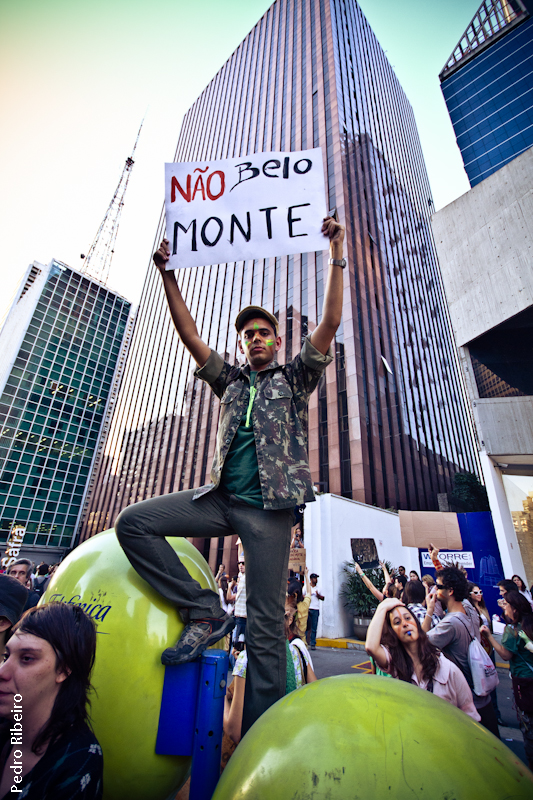The policy and process to compensate indigenous groups affected by the construction of the Belo Monte dam by the operating company Norte Energia allegedly stirred up conflicts and divisions within these indigenous groups, exemplifying how compensation policies can corrupt communities.
 Photo: Pedro Ribeiro / Flickr
Photo: Pedro Ribeiro / FlickrBelo Monte is the third largest hydropower plant in the world. It is located in the Brazilian Amazon, at the Xingu River Basin. The project was first conceived in the 1970s and has been opposed by local organisations and communities ever since.[1] After an energy crisis in the early 2000s, the government decided to build the hydropower plant in spite of local opposition.
The construction of the dam by Norte Energia had a severe impact on indigenous communities in multiple ways.[2] This included the resettlement of 40,000 people, loss of livelihoods due to environmental changes, and social problems associated with population inflow such as increased violence and substance abuse.[3] Brazilian public authorities mandated a series of mitigation and compensation measures specifically directed at protecting indigenous populations.
However, the application of these measures faced repeated delays, leading Norte Energia to adopt an “Emergency Plan” to address the communities’ needs pending implementation of the mandated measures.[4] The Emergency Plan consisted of 30,000 reais (€5,400 approx.) assigned to each indigenous group (called an aldeia), which would be paid in the form of consumer goods chosen by the community.[5] The decision about which goods should be requested and how they should be distributed led to conflicts within the aldeias. Indigenous groups were not used to dealing with the management and division of such a large number of resources.[6]
There was also disagreement within the aldeias about whether to support the dam project or not. Dissident groups started leaving their traditional communities over these divergences to start their own aldeias (which in turn would be entitled to their own Emergency Packages). According to Antônia Melo da Silva, a local activist, “the first impact [of the company’s actions] was the division of the community, a strategy by the company […] to weaken the people, who became divided and started fighting with each other.”[7] Due to this dynamic, the number of aldeias grew from 22 to 38 in a single year.[8]
As a consequence, Brazil’s Public Federal Prosecutor’s Office engaged in a prolonged investigation of the case, resulting in its decision to start a public civil action[9] against Norte Energia and the Brazilian Federal Government’s National Indian Foundation (FUNAI) based on “ethnocide” charges.[10] The main allegation is that the Belo Monte dam “constitutes ethnocide by the Brazilian State and the concessionaire Norte Energia, ‘evidenced by the destruction of the social organization, customs, languages and traditions of the impacted indigenous groups’”.[11]
The documentation collected by the Prosecutor’s Office includes revealing quotes from indigenous people affected by the project. As indigenous villager Kaworé Parakanã elaborates: “In the beginning, when the plant was to be built, it was all of us, people from the Altamira region. We were united. With a lot of strategy, the rulers, they divided the peoples.”[12]
The Prosecutor’s charges describe Norte Energia’s policy as one of pacification and silencing. The emergency plan is regarded as a trajectory outside the norms of licensing, defined far from the legitimate spaces for indigenous participation and protagonism. Through this approach the company was successful in attracting indigenous people to their offices and keeping them away from the Belo Monte construction sites, without complying with the mandatory conditions of the concession agreements.[13]
There is no final judgment in this public civil case yet. The latest publicly available information on the proceedings shows that, on 10 September 2019, the court affirmed that indigenous organisations have opposed the continuation of the chamber of conciliation that was established to reach an agreement between the Federal Prosecutor’s Office, indigenous peoples and Norte Energia.[14]
In its response to a review request made by the Mind the Gap research team, Norte Energia commented that the above-mentioned chamber of conciliation was established upon consensus and is still ongoing. Furthermore, the company stressed that, from the start of its operations in 2010, it has operated in compliance with all applicable laws, protocols and conventions, and under approved licences.
The company also describes its efforts and contributions to the wellbeing of the indigenous communities living in the Belo Monte area, including cultural, educational and social projects, water and sanitation projects, and the establishment of a consultation and response mechanism. The company has not directly responded to the central allegation of this case study: the divisive effect of its compensation policies.
[1] Xingo+. “Uhe Belo Monte.” https://xingumais.org.br/obra/uhe-belo-monte (accessed May 11, 2020)
[2] Interamerican Association for Environmental Defense, “Inter-American Commission urges Brazil to address damages to indigenous peoples caused by Belo Monte Dam,” November 13, 2018, https://aida-americas.org/en/press/inter-american-commission-urges-brazil-address-damages-to-indigenous-peoples-caused-by-belo-monte (accessed December 16, 2019); Xingo+
[3] Zoe Sullivan, “Brazil’s dispossessed: Belo Monte dam ruinous for indigenous cultures,” Mongabay, December 8, 2016, https://news.mongabay.com/2016/12/brazils-dispossessed-belo-monte-dam-ruinous-for-indigenous-cultures/ (accessed December 16, 2019).
[4] Jonathan Watts, “Belo Monte, Brazil: The tribes living in the shadow of a megadam,” The Guardian, December 16, 2014, https://www.theguardian.com/environment/2014/dec/16/belo-monte-brazil-tribes-living-in-shadow-megadam (accessed October 28, 2019).
[5] Lola Hierro,“O Governo e Belo Monte têm uma dívida impagável com a população do Xingu e de Altamira,” El País, October 23, 2017, https://brasil.elpais.com/brasil/2017/10/09/politica/1507550012_733072.html (accessed October 28, 2019).
[6] Ministério Público Brasileiro. “Desculpe, Mas Esta Página Não Existe….” http://www.mpf.mp.br/pa/sala-de-imprensa/documentos/2017/caso-belo-monte/3017-82-2015-4-01.3903/acp_belo_monte_componente_indigena_2.pdf/view,%20p.%2036. (accessed May 11, 2020)
[7] Lola Hierro, 2017.
[8] Pereira, Renée. “Hidrelétrica De Belo Monte Divide Aldeias No Xingu.” Estadão, January 4, 2015. https://economia.estadao.com.br/noticias/geral,hidreletrica-de-belo-monte-divide-aldeias-no-xingu-imp-,1615198 (accessed May 11, 2020); Ministério Público Federal. “Procuração – Ação Etnocida Do Estado e Da Norte Energia Sa.” Page 36, http://www.mpf.mp.br/pa/sala-de-imprensa/documentos/2017/caso-belo-monte/3017-82-2015-4-01.3903/acp_belo_monte_componente_indigena_2.pdf/view. (accessed May 11, 2020)
[9] Ministério Público Federal (“Procuração”).
[10] Ministério Público Federal. “MPF/PA denuncia ação etnocida e pede intervenção judicial em Belo Monte.” http://www.mpf.mp.br/pa/sala-de-imprensa/noticias-pa/mpf-denuncia-acao-etnocida-e-pede-intervencao-judicial-em-belo-monte; Sullivan, 2016. (accessed May 11, 2020)
[11] Ministério Público Federal (“Denuncia”)
[12] Ministério Público Federal (“Procuração”), Page 36.
[13] Ministério Público Federal (“Denuncia”); Ministério Público Federal (“Procuração”).
[14]Justiça Federal. “0003017-82.2015.4.01.3903.” https://processual.trf1.jus.br/consultaProcessual/processo.php?proc=30178220154013903&secao=ATM&nome=NORTE%20ENERGIA%20S.A&mostrarBaixados=N (accessed May 12, 2020)
